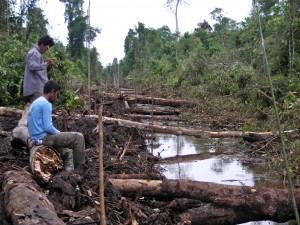
Since joining RAN’s forest program over two years ago, I have read and written about the many dire consequences of industrial scale palm oil plantations in Indonesia: one of the highest deforestation rates in the world, critical habitat for endangered species like orangutans destroyed, gross human rights abuses and labor conditions, and social conflict between communities that depend on the forests for their livelihoods and the companies destroying those forests. But until recently, my personal connection to all of this remained largely academic.
Our trip to the wilds of Borneo this month after attending the annual meeting of the Roundtable on Sustainable Palm Oil (RSPO) has transformed my theoretical understanding of the problems with palm oil. The experience of witnessing these impacts in person has been staggering, and I found it hard to believe that, even on the edge of a globally treasured, protected area, I was able to document one of the most severe cases of active forest destruction from palm oil expansion I have heard about to date.
[set_id=72157628394790421]
What I saw during the four days we toured the forests surrounding Borneo’s Tanjung Puting National Park was more extraordinary and devastating than anything I could have imagined. The weight of my realization about what’s at stake hit me hard the day we spent walking through old-growth tropical rainforest, seeing wild orangutans, Horn Bills, Proboscis monkeys, and the recent evidence of a Sun Bear clawing a tree for honey, followed by an afternoon watching an excavator tearing down towering trees and digging a drainage canal into one of the last areas of natural forest remaining in the buffer zone of the park. We were on the edge of a community agroforestry project designed to demonstrate an alternative to destructive monoculture in an area almost entirely razed to make way for palm oil plantations.
We watched, horrified, as an irreplaceable hotspot of biodiversity fell before our eyes, two majestic Horn Bills flew overhead, and an endangered Red Langur monkey peered at us through the trees.
After spending a full day documenting human rights abuses with our allies from Save Our Borneo, an organization working on the frontlines of Central Kalimantan’s palm oil expansion crisis, RAN forest team member Lafcadio Cortesi and I took a night bus across Borneo from the city of Palangkaraya to Pangkalanbun. Even though the landscape was shrouded in darkness, the endless sea of sterile palm oil plantations beyond the road stood out throughout our entire 11 hour journey — a grim reminder that the province of Central Kalimantan has one of the fastest rates of oil palm expansion in Indonesia, perhaps even in the world.
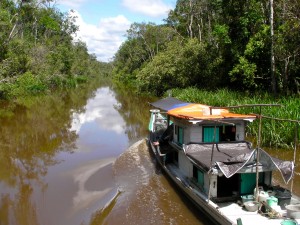
Around 4am we arrived in the small port town of Kumai at the office of Friends of the National Parks Foundation (FNPF), the incredible organization my colleague Laurel visited in Bali earlier this year that also operates community development and reforestation projects in Borneo. I collapsed in a makeshift bunk bed and fell asleep to the sounds of Indonesian sunrise: distant speakers blaring Muslim calls to prayer, a singing gecko, a rooster crowing, and a chainsaw running somewhere behind the little house we slept in.
A few hours later we were racing to the edge of the Kumai River on motorbikes to travel by speed boat to the Sekonyer River, the gateway to Tanjung Puting National Park. Tanjung Puting is a globally recognized biosphere reserve and an unparalleled diversity hotspot. It’s home to many endangered species such as orangutans and Clouded leopards. Despite the incredible importance of Tanjung Puting, the park and its surroundings — the buffer zone — are under threat from illegal logging and mining operations and, most ominously, the encroachment of palm oil.
The reckless, short-sighted expansion of palm oil plantations in Central Kalimantan is pushing many of these species to the brink of extinction, literally leaving them with nowhere to go. The disappearing rainforest we witnessed falling is sandwiched between the Sekonyer River, the national park, and 10,000 hectares of plantations. Inside the national park, orangutans have more hope of survival. But orangutans can’t swim, so when we saw a pregnant orangutan mother with her young children on the west side of the river — where the forest was actively being converted to oil palm plantation — my heart sank.
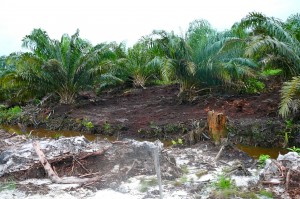
The deeper in we got, the more severe the problems. The drainage canals along the edge of the plantations were filled with the dark black water of dissolved peat soil — highlighting the troubling reality that the much of this plantation was on top of carbon-rich peat soils and thus emitting massive amounts of CO2 as it rots upon being exposed to the air. In the converted peatlands, many of the oil palms were growing sideways and some even falling over. It seemed certain that the yields were marginal and the costs — the loss of a thriving and rare ecosystem and community livelihoods — was great. It seemed sure the Indonesian law prohibiting conversion of deep peatlands was being violated.
Responsible for this mess is BW Plantations, an RSPO member with about 100,000 hectares (240,000 acres) of oil palm plantations in Central and East Kalimantan. In addition to its draining of peatlands and destroying primary forests right up against a national park filled with many of the world’s last orangutans, the company is also grossly disrespecting the rights of the local community.
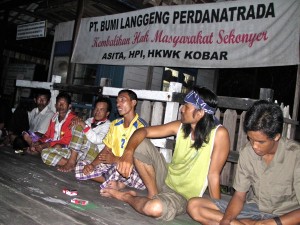
The vibrant village of Tanjung Harapan on the Sekonyer river has over 100 families who are actively opposing the palm oil plantation and its expansion. Immediately upon entering the village by water, we saw two huge protest banners and a large sign reading, “PT Bumi Langgeng: Return the Rights of the Sekonyer Community.” The community members depend on the forest for their livelihoods and see the encroaching palm oil as a threat to their reliance on community food gardens, agroforestry, and fishing. They are angry that the palm oil plantation has used over 2,200 hectares (over 5,000 acres) of their village lands without any consultation or approval.
During our stay in the Sekonyer community, we slept under mosquito nets on a boat on the river’s edge. Our second night we met with community leaders and they told us their story. We learned that the community has been at odds with the palm oil company PT Bumi Langgeng, a subsidiary of BW Plantations, for many years over a land conflict. In the last several months, community resistance has escalated as land clearing continues at breakneck speed. I could actually hear the bulldozers demolishing forest from the community garden — to say it was unsettling would be a major understatement.
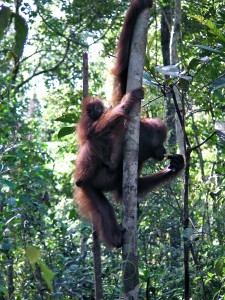
When the company cut down the community’s native rubber trees around six months ago, it triggered the first demonstration. Police showed up but no one was arrested. The latest demonstration took place just a few months ago after community leaders sent formal letters of complaint to the company as well as the district, provincial, and national governments seeking recognition of their lands, compensation for the 2,200 ha. of community land already taken by the company, and a halt to further expansion into forests and remaining community lands. Community members blocked the canal from the palm oil plantation to the main river. So far they have not received any response.
This is the true cost of palm oil. Is it worth it?
As the cheapest, highest-yielding vegetable oil and now the most heavily traded edible oil in the world, I understand that companies benefit from this lucrative industry so dependent on cheap labor and precious yet cheap rainforests. But at what price are we going to continue expanding this commodity? Expansion of palm oil into ecological and cultural hotspots needs to stop. The community of Sekonyer needs our support to secure their rights and justice. The time is ticking for the orangutans and other species depending on the forests — if they can’t be protected from palm oil expansion on the edge of a national park, the prospects for responsible palm oil look grim.